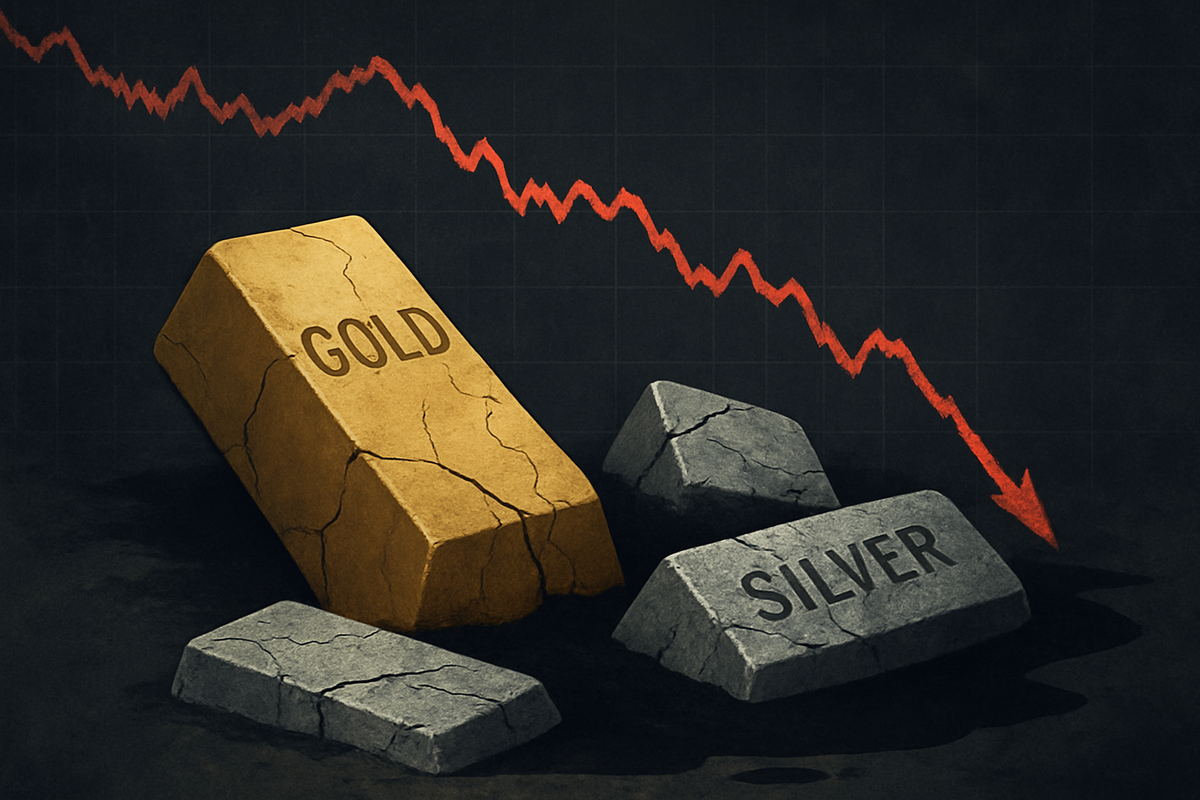
October 21, 2025 – The S&P 500 Materials sector experienced a significant downturn today, with its underperformance largely driven by a sharp decline in the prices of gold and silver. After an extended period of robust gains that saw precious metals reach multi-year highs, a wave of profit-taking combined with shifting market sentiment triggered a substantial sell-off, leaving gold and silver mining stocks reeling. This sudden reversal has prompted investors to reassess the sustainability of the recent rally in safe-haven assets and the immediate outlook for companies deeply entrenched in the precious metals industry.
The immediate implications are clear: a direct hit to the profitability and market valuations of gold and silver producers, leading to widespread stock declines across the sector. This event serves as a potent reminder of the inherent volatility within commodity markets and the delicate balance between investor confidence, macroeconomic indicators, and geopolitical stability.
Detailed Coverage: A Sharp Correction in Precious Metals
October 21, 2025, marked a notable shift in the precious metals landscape, as both gold and silver prices plummeted, experiencing their most substantial single-day declines in years. Spot gold fell by an estimated 6.3%, dropping to approximately $4,082.03 per ounce from a recent record high of around $4,381.50 per ounce. Silver, known for its higher volatility, saw an even steeper decline of 8.7%, with its price falling to about $47.89 per ounce from a high of $54.50 per ounce. This correction followed a period where gold had gained approximately 60% year-to-date, making the market ripe for profit-taking.
Several factors converged to trigger this sharp downturn. A significant strengthening of the U.S. dollar, which rose by 0.4% today, made dollar-denominated precious metals more expensive for international buyers, dampening demand. Simultaneously, expectations of rising interest rates or higher yields on alternative investments increased the opportunity cost of holding non-yielding assets like gold and silver. Reports of easing geopolitical tensions, particularly optimistic trade talks between the US and China, further diminished gold's appeal as a safe-haven asset, encouraging a shift towards "risk-on" investments. This sentiment was compounded by widespread profit-taking after an "overcrowded" market had run "a little hot."
The immediate market reaction from precious metal mining stocks was severe. Major gold producers like Barrick Gold Corporation (NYSE: GOLD), Newmont (NYSE: NEM), and Agnico Eagle Mines (NYSE: AEM) all experienced significant slides, with some reports indicating declines of more than 8% in early trading. Streaming companies such as Wheaton Precious Metals (NYSE: WPM) also saw similar drops. The VanEck Gold Miners ETF (NYSEARCA: GDX), which tracks leading gold miners, plunged by approximately 9.5%, marking its worst session since the pandemic-induced market turmoil of March 2020. This synchronized fall underscored a darkening profitability outlook for producers, as lower commodity prices directly pressure margins.
Companies Facing Headwinds and Potential Beneficiaries
The dramatic fall in gold and silver prices today has created distinct winners and losers across the financial markets, with precious metal mining companies bearing the brunt of the impact.
Major gold and silver mining companies are directly exposed to commodity price fluctuations. For Barrick Gold (NYSE: GOLD), Newmont (NYSE: NEM), and Agnico Eagle Mines (NYSE: AEM), the direct reduction in the per-ounce value of the metals they extract immediately translates into lower revenues. Assuming production costs for labor, equipment, and energy remain relatively stable, their profit margins will contract significantly. This pressure is particularly acute for higher-cost producers, and sustained lower prices could lead to reduced capital expenditure, deferred exploration projects, or even the unviability of marginal operations. Their stock performances have mirrored the commodity declines, with shares plunging by significant percentages as investors recalibrate valuations.
Wheaton Precious Metals (NYSE: WPM), a streaming company, operates with a slightly different model, acquiring a percentage of future production at a discount. While this model offers some protection and typically results in high cash operating margins, a substantial drop in metal prices still reduces the spread they earn, impacting their cash flows and profitability. Their stock performance is also closely correlated with the underlying commodity prices, experiencing similar downward pressure today.
Conversely, certain industries stand to indirectly benefit from lower precious metal prices. Industrial users, particularly those in electronics manufacturing (e.g., smartphones, computers), solar panel production, and the automotive industry (especially electric vehicles), which rely on silver and gold as critical components, could see a reduction in their input costs. This cost saving could potentially boost their profit margins, assuming consumer demand for their products remains robust. For example, lower silver prices are highly favorable for solar panel manufacturers, given silver's significant role in their production.
The jewelry industry is another potential beneficiary. A fall in gold and silver prices means jewelers can procure their raw materials at a lower cost. This can improve their profit margins on new inventory and, if savings are passed on, potentially stimulate consumer demand for jewelry, which often sees reduced sales during periods of high metal prices. However, the overall economic sentiment accompanying such a price drop could also influence consumer spending on luxury items.
Wider Significance: A Shift in Market Dynamics
The significant drop in gold and silver prices on October 21, 2025, extends beyond the immediate impact on mining stocks, signaling a broader recalibration of market dynamics and investor sentiment. This event fits into a pattern where strong rallies in precious metals are often followed by corrections, especially when underlying economic and geopolitical conditions shift.
A key aspect of this shift is the safe-haven status versus risk-on sentiment. Gold and silver traditionally serve as safe havens during times of economic uncertainty or geopolitical instability. Today's price plunge suggests a potential move by investors away from defensive assets and towards riskier, higher-growth assets like equities, implying renewed confidence in the global economy and a reduction in perceived risks, possibly fueled by easing US-China trade tensions.
The relationship between inflation, interest rates, and the U.S. dollar is also crucial. Precious metals tend to thrive in high-inflation environments or when real interest rates are low, as they offer an alternative store of value to depreciating fiat currencies. A strong U.S. dollar, as seen today, makes gold and silver more expensive for international buyers, exerting downward pressure. Furthermore, expectations of rising interest rates or delays in anticipated rate cuts by central banks make non-yielding assets less attractive compared to interest-bearing alternatives.
Ripple effects will be felt throughout the precious metals ecosystem. Beyond mining companies, refiners and dealers might experience reduced profitability, while investors in gold-backed ETFs will see their values diminish. For industrial users of silver, such as those in the burgeoning electronics and renewable energy sectors, lower prices could be a boon, reducing input costs and potentially improving competitiveness. Central banks, which have been significant accumulators of gold in recent years, will be closely watching these price movements as they consider their reserve diversification strategies.
Historically, such sharp declines are not unprecedented. The early 1980s, with aggressive interest rate hikes by the U.S. Federal Reserve, saw gold prices fall dramatically. The 2013 "Taper Tantrum," when the Fed signaled a tapering of quantitative easing, also led to a significant gold price decline. Today's 6.3% gold drop is the most substantial since April 2013, drawing a direct comparison to that period of monetary policy normalization. These historical precedents suggest that while today's drop is sharp, it aligns with a pattern of market corrections driven by shifts in monetary policy expectations and broader economic sentiment.
What Comes Next: Navigating the Volatile Waters
The immediate aftermath of today's significant drop in gold and silver prices will likely be characterized by continued volatility and intense market scrutiny. In the short term, analysts suggest that this correction, while sharp, might be a "healthy" or "necessary tactical retreat" after an extraordinary rally, potentially setting the stage for further profit-taking or a period of consolidation. However, it is also viewed by some as an attractive entry point for long-term investors bullish on precious metals.
Looking at the long-term possibilities, the fundamental drivers supporting gold and silver largely remain robust. Persistent concerns about waning confidence in fiat currencies, ongoing central bank accumulation of gold, and increasing industrial demand for silver (especially from green technologies like solar panels and electric vehicles) are expected to provide a floor for prices and potentially fuel a resumption of the upward trend. Geopolitical instability, despite today's easing tensions, remains a background factor that can quickly reignite safe-haven demand.
For mining companies, strategic pivots are essential. They will need to intensify their focus on cost optimization and operational efficiency to maintain profitability in a lower price environment. This includes reviewing capital expenditure plans, prioritizing high-margin operations, and potentially deferring non-essential expansion projects. Companies with strong balance sheets and lower "all-in sustaining costs" (AISC) will be better positioned to weather the storm, and some may even explore strategic acquisitions of distressed assets. Effective hedging strategies will also be crucial to mitigate future price volatility.
Emerging market opportunities remain significant, particularly as central banks in these regions continue to diversify their reserves away from the U.S. dollar by accumulating gold. This structural demand provides a long-term tailwind. However, nations heavily reliant on gold production could face economic challenges if prices remain subdued. Meanwhile, emerging markets with expanding electronics and renewable energy sectors will continue to drive industrial demand for silver.
Potential scenarios include a healthy correction followed by a resumption of the bull trend, driven by underlying structural factors. Alternatively, a prolonged consolidation or temporary bearish phase could emerge if global economic improvements continue, geopolitical tensions further ease, and the U.S. dollar strengthens significantly. Silver, due to its smaller market size and dual demand profile, is likely to exhibit amplified volatility. Ultimately, monetary policy decisions by central banks, particularly regarding interest rates, are expected to increasingly dominate the direction of precious metal prices.
Wrap-up: A Market in Transition
Today's underperformance of the S&P 500 Materials sector, specifically the sharp decline in gold and silver stocks, marks a pivotal moment in the precious metals market. The significant drops in gold and silver prices—gold's steepest daily fall in five years and silver's largest since 2021—were primarily triggered by widespread profit-taking after an extended rally, a strengthening U.S. dollar, and easing geopolitical tensions. This event underscores the inherent volatility of commodity markets and the profound impact of macroeconomic shifts on sector-specific performance.
Moving forward, while short-term volatility is expected, the long-term outlook for gold and silver remains fundamentally robust. Underlying drivers such as persistent inflation concerns, ongoing central bank accumulation, and robust industrial demand for silver are anticipated to provide sustained support. The S&P 500 Materials sector's trajectory will largely depend on the stability of commodity prices and broader economic conditions, with potential interest rate cuts and global liquidity expansion offering future tailwinds.
The lasting impact of today's event may be a renewed emphasis on fundamental analysis over momentum trading in precious metals. It serves as a powerful reminder that even safe-haven assets are susceptible to significant corrections. While individual mining stocks may face immediate headwinds, the strategic value of precious metals in a diversified portfolio, particularly as a hedge against systemic risks, is unlikely to be fundamentally altered.
What investors should watch for in coming months:
- Macroeconomic Indicators: Closely monitor global liquidity trends, central bank interest rate policies (especially from the Federal Reserve), and the strength of the U.S. dollar.
- Geopolitical Developments: Any resurgence in global uncertainty or geopolitical tensions could quickly reignite safe-haven demand for precious metals.
- Company Fundamentals: For those invested in mining stocks, a rigorous assessment of individual company financials, including "all-in sustaining costs" and balance sheet strength, will be crucial.
- Industrial Demand Trends: Keep an eye on the growth of sectors heavily reliant on silver, such as electronics, solar, and electric vehicles, as their demand can significantly influence silver prices.
- Market Sentiment: Observe shifts in investor sentiment and positioning, as profit-taking after rallies can continue to trigger corrections.
The recent rally in gold and silver made 2025 a remarkable year for precious metals until today's sharp correction. This event highlights the dynamic nature of commodity markets and necessitates a vigilant, informed approach for investors navigating the S&P 500 Materials sector in the coming months.
This content is intended for informational purposes only and is not financial advice






